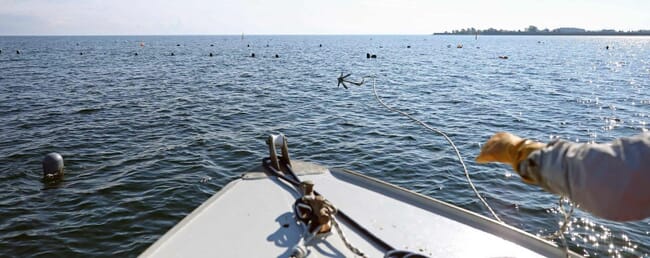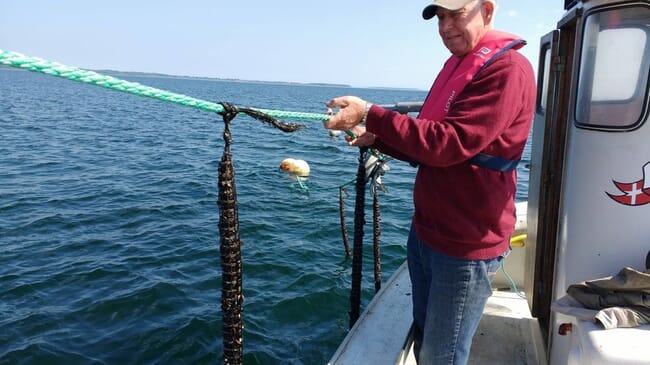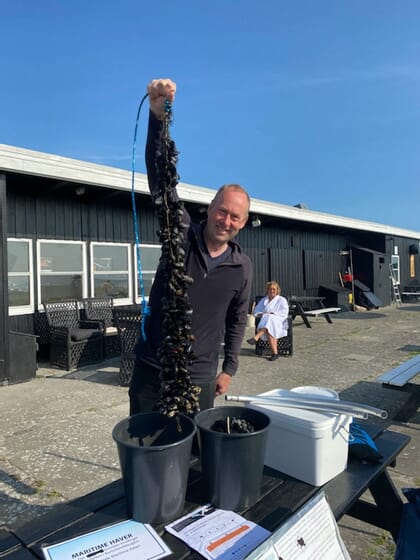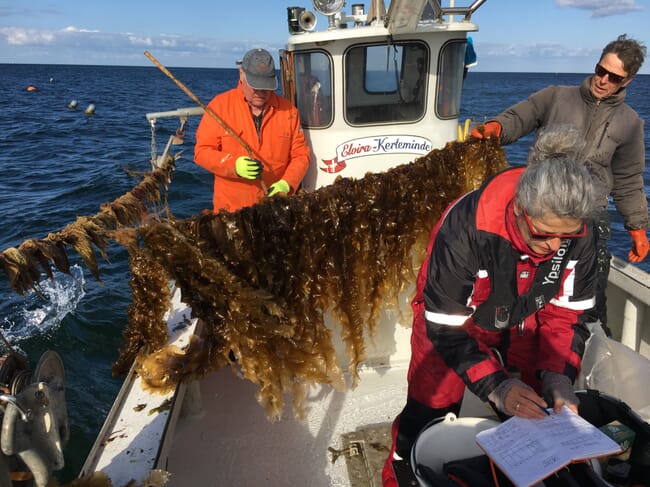
The Kerteminde mussel farm is the biggest community mussel farm in Denmark
“The idea of an allotment for growing mussels came up after study at the local university, in which researchers were able to grow mussels on lines to an eatable size in just one year,” explains Bernt Kjær Sørensen, chairman of Kerteminde Maritime Haver, on the east coast of Funen.
The idea gained further impetus when Sørensen discovered that a community near Aarhus had recently set up its own – successful – small-scale mussel farm.
“So [in 2015] along with a few other citizens of Kerteminde, we decided to start a society and pick up this way of growing mussels. We are now the biggest community mussel farm in Denmark,” he explains.
According to Sørensen, the comparative simplicity of small-scale mussel production was part of the appeal, as was the relatively low capital outlay required – thanks in part to funding to help with the largest capital requirement, a workboat, complete with two winches for laying and lifting the mussel lines.

The comparative simplicity of small-scale mussel production and low capital outlay made the sea allotments appealing
“We were able to find an old but well-sized workboat with suitable equipment. Our budget was 300,000 kroner [£34,000], which we got via funding. This covered buying the boat, as well as anchors, chains and buoys,” Sørensen reflects.
The society currently has about 80 households as members – with each paying an annual subscription of 500 kroner (£60). In return they get access to a generous supply of mussels for their own use, and many of them meet for monthly communal mussel feasts.
Despite the group having no previous aquaculture experience, the biggest setback they’ve had to date was when migrating eider ducks wiped out an entire crop one winter. To prevent a repeat of that incident they now bring their lines into the local harbour for the winter, where they are safe from the ducks, while their members can easily pick their fill as and when they want to.

The group says that the licensing process was one of the biggest challenges they faced when starting out
Other than the hungry ducks, the licensing process was probably the biggest challenge for the society.
“This was a very long process. We had to apply to many authorities. Permissions to reserve and mark the area, permissions to grow mussels, permissions to grow kelp and several public consultations with local stakeholders, including recreational sailors,” Sørensen recalls.
However, after several months, they were awarded a lease on a site 100 m by 200 m site, that sits 500 m from the shore, where the water is around 5-6 m deep.
“It’s not very visible from the shore, and we’ve had no opposition to it from local sailors whatsoever,” Sørensen explains.
As well as keeping their members in mussels, the site is also proving to be something of a biodiversity hotspot.
“Our divers tell us that it looks very nice under the allotment. There is good growth in the seaweed on the seabed and anchors. They see many fish too. It’s in contrast to the seabed outside the allotment, which is just sand,” Sørensen notes.
Key tasks
While not all members are active in the production of the mussels, there are enough willing hands to ensure the key jobs are done, starting with setting out the collection lines for the mussel spat to settle on in May and June.
As the season goes on grading and harvesting take over as the main tasks – and Sørensen says that between 10 and 20 of their members tend to take part in these activities, with two or three grading trips typically required on each line before harvest. Although the mussels might be edible after one year – as suggested by the study that inspired the society – Sørensen prefers to grow them for 18-24 months.
“We gather a few times a year to sort all our mussels and prepare new lines – both existing lines where we sort the size of the mussels, and new lines based on the [juvenile] mussels that have settled on the ribbons,” explains Sørensen.

Sørensen and the other farmers bring the mussel lines into the local harbour for the winter to prevent predation and make harvesting easier
Once the ropes are deemed to have a good enough crop they are towed into the harbour and hung off the side of a jetty in manageable lengths – allowing society members to come and take all the mussels they need, without the need of any machinery to lift the ropes.
This hand-to-mouth harvesting means that Sørensen is unsure of the exact tonnage of mussels produced by the society each year. While they are content with their current volumes – and to maintain the non-commercial approach, Sørensen says that he does toy with the idea of organising an annual mussel festival as a means to remind a wider audience of the benefits of these bivalves.
“We’d like to see more Danish people eating mussels – like they do in France or Spain – young and old, eating outside – and we’d like to spread the knowledge,” he reflects.
“While it’s possible to buy mussels in supermarkets here, they have mainly been harvested from the seabed and can be gritty, or come in tins, and not as good quality as line-grown mussels. May people are pleasantly surprised by the quality of the ones we grow,” he adds.

The society currently has about 80 households as members and many of them meet for monthly communal mussel feasts
In the meantime they have recently started to explore kelp farming, alongside the mussels.
“I think kelp production is a very exciting part of our society. There is a big potential in using kelp for food that we have almost forgotten. We experiment using it when our society gather: we dry it, roast it in the oven, use it when baking bread, in salads. We also make our own beer, where we add kelp – the beer is very popular,” he chuckles.
While the beer might be flowing already, Sorensen admits that seaweed is proving tougher than mussels to produce.
“Growing mussels works quite well. We have a lot to learn on growing seaweed. We are trying different ways of growing seaweed, using lines and nets. We currently grow sugar kelp, bladderwrack and dulse,” he explains.
“The vast majority of our members joined to eat mussels, but a small group is experimenting with seaweed with great enthusiasm. We’re all amateurs, but our group includes chefs and even a professor of seaweed and we have connections to universities who are helping us make the lines for the kelp,” he adds.
Looking ahead
According to Sorensen, there is now hope that the licensing process for establishing sea allotments will soon be streamlined, as more and more are established. There are currently 15 that he’s aware of in Denmark, as well as another dozen or so in the planning phase, and he welcomes the growth.
“We share our thoughts and help new societies in the start up process. The more societies the merrier! We gather once or twice a year with representatives of the other societies,” he explains.

Kerteminde Maritime Haver have recently started to explore kelp farming, alongside the mussels
Despite holding down two jobs – one in IT, the other building floating wooden platforms that people can picnic or camp on – Sorensen’s enthusiasm for mussel growing remains undimmed.
And his advice to those considering setting up their own societies?
“Get on with it! – start small scale. There is no need to have a big allotment to start with. All you need is a line with some buoys attached to an anchor. With just 10-metre line floating at the surface there is plenty space to start growing mussels and kelp side by side on drop lines. Keep the drop lines short – amount 1 metre is fine. If they get too long, they become too heavy, and the mussels tend to fall off when harvesting,” he concludes.




